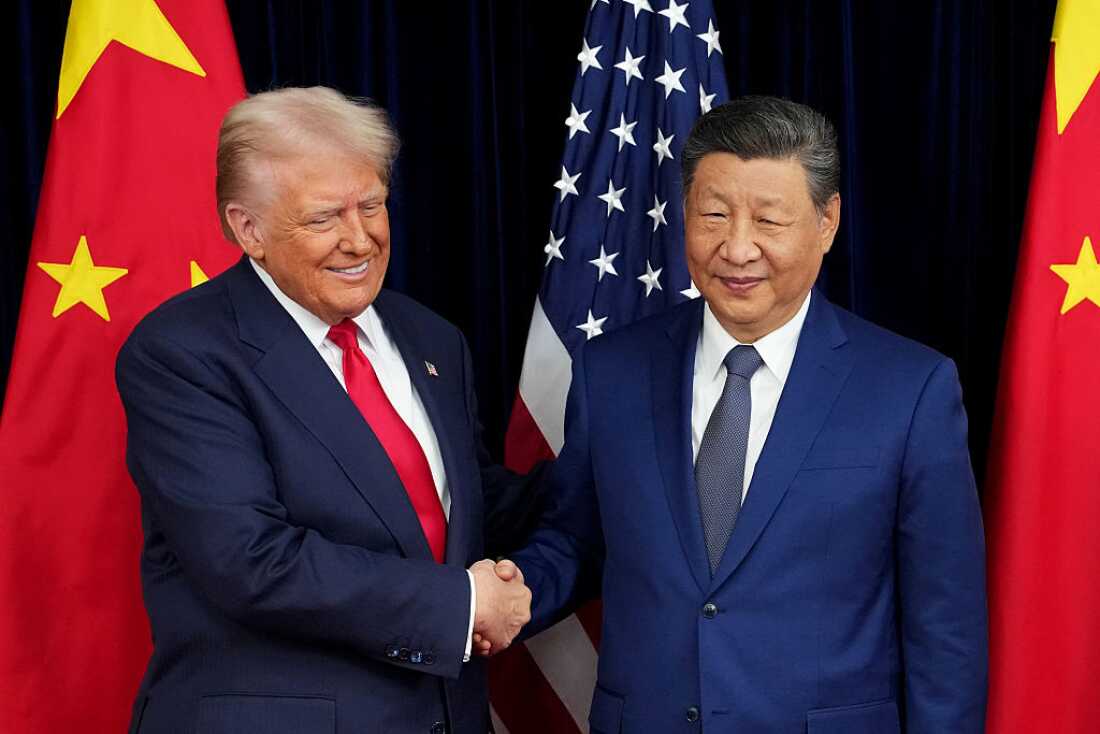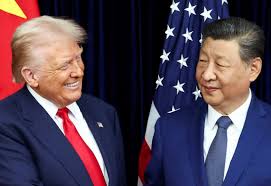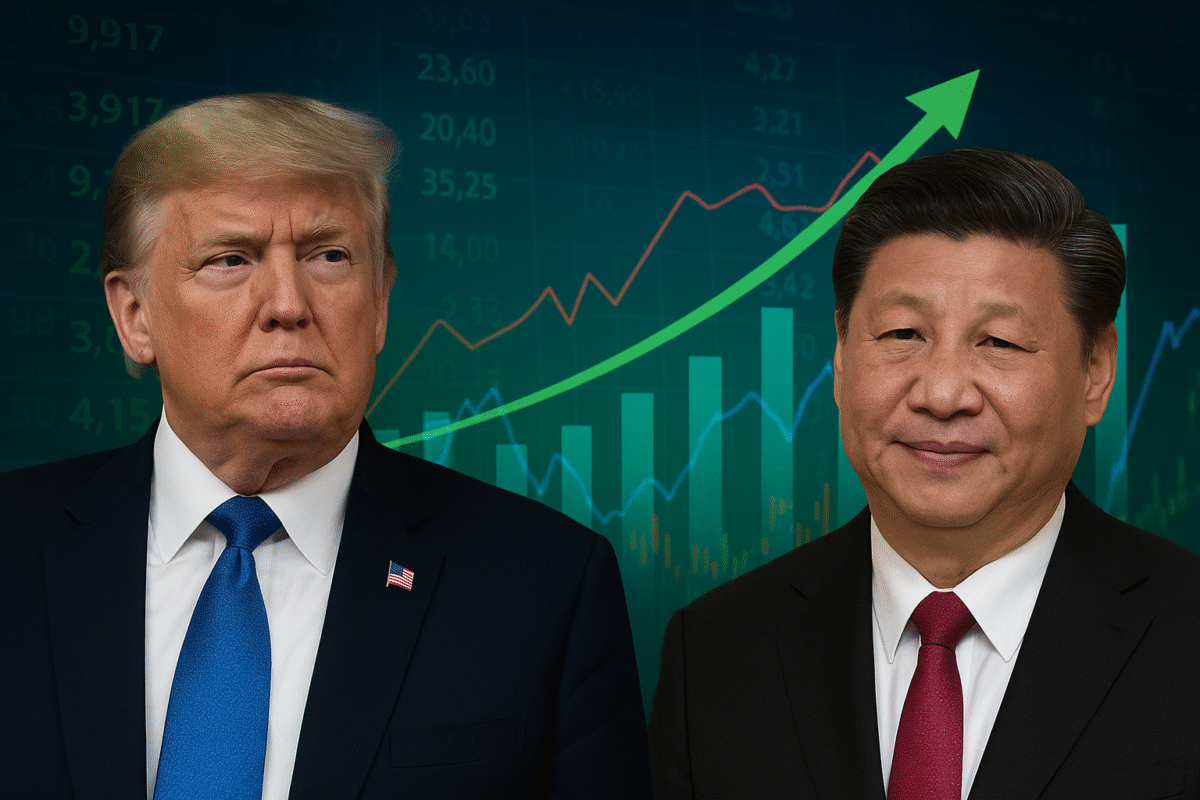Tariff truce & turf wars: Trump and Xi meeting yields soybeans, rare earths and fentanyl deal

U.S. President Donald Trump greets Chinese President Xi Jinping ahead of a bilateral meeting at Gimhae Air Base on October 30, 2025 in Busan, South Korea. Image Source: Andrew Harnik/Getty Images
On October 30, 2025, Donald Trump and Xi Jinping met for the first time since early 2019 at the Gimhae Air Base in Busan, South Korea. The 1-hour 40-minute meeting came amid escalating tensions over trade, technology and security between the world’s two largest economies.
President Trump described the encounter as “an amazing meeting… I’d say it was a 12 out of 10,” underscoring the significance the U.S. places on this reset.
Despite previous flashpoints, such as the threatened 100 % tariffs and China’s rare earth export curbs, both sides arrived aiming to stabilise relations. Analysts had cautioned that expectations should be modest, but the Busan summit appears to have delivered concrete commitments.
Major Trade and Tariff Shifts: What Was Agreed
A core outcome of the meeting was a bundle of agreements tying tariff relief to China’s cooperation on strategic issues. The U.S. announced it would cut specific tariffs: notably, the fentanyl-related levy on Chinese goods will drop from 20 % to 10 %.
In exchange, China agreed to resume large-scale purchases of U.S. soybeans and agricultural products, restore rare earth export flows and to “work very hard” to disrupt the flow of fentanyl precursor chemicals entering the U.S. market.
Moreover, Trump said “there’s no road-block at all on rare earths … that’s for the world,” referencing a one-year suspension of China’s export curbs.
READ ALSO
Japanese PM Takaichi and Trump forge a ‘Golden Age’ alliance amid global power shift
Agriculture and Rare Earths: Strategic Gains for the U.S.
The revived China-U.S. agricultural trade is a win for American farmers, especially amid years of Chinese import boycotts. Trump said China would begin buying “tremendous amounts” of soybeans immediately.
On the rare earth front, China dominates global processing supply chains critical to electronics, EVs and defence hardware. The Busan deal delays Beijing’s export control plan and ensures U.S. access to supplies, mitigating a key strategic vulnerability for Washington.
Fentanyl Crackdown: A U.S. Priority Gets a China Component
The U.S. government has long argued that China is responsible for precursor chemicals that fuel the fentanyl crisis in America. At the summit, Trump said Xi would commit to “take strong action” and this pledge enabled the tariff cut.
While details are still pending, this linkage signals a shift: trade policy is now explicitly tied to drug flow enforcement, a rare coupling of economic and law-enforcement diplomacy.
What Was Left Off the Agenda: Taiwan, Advanced Chips and More
Despite the wide range of issues addressed, Trump confirmed that the status of Taiwan “did not come up.”
Likewise, exports of the U.S. tech giant Nvidia’s highest-end “Blackwell” chips to China remain off the table, though lower-tier chip exports may be discussed.
Strategic analysts caution that structural issues, such as intellectual-property theft, manufacturing overcapacity and military-civil fusion, were not resolved and may resurface.
Next Steps and Market Reactions
In remarks aboard Air Force One, Trump said the deal will be reviewed annually but could extend beyond a year. He also announced that he would visit China in April, and Xi would visit the U.S. thereafter. Markets reacted swiftly: Asian equities initially surged on the ‘deal’ signal, though the reaction was volatile as details remain unclear.
Implementation now becomes key. U.S. trade negotiators and Chinese counterparts must hammer out the fine print, verify China’s botanical purchases and monitor rare-earth flows and precursor-chemical controls.
FAQ – Trump Xi Meeting 2025
Q: What was the purpose of the Trump-Xi meeting?
A: The summit aimed to de-escalate trade and strategic tensions between the U.S. and China, focusing on tariffs, rare earths, agricultural purchases and fentanyl precursor controls.
Q: What key agreements were reached?
A: China agreed to resume U.S. soybean purchases and delay rare-earth export restrictions, while the U.S. agreed to cut certain tariffs (e.g., fentanyl-related tariffs) and resume trade dialogue.
Q: How will the agriculture sector benefit?
A: U.S. farmers gain access to China’s market again as Beijing committed to buy “tremendous amounts” of soybeans and other agricultural goods.
Q: Why are rare earths significant in this deal?
A: Rare earths are critical to high-tech, defence and manufacturing supply chains. The agreement prevents China from imposing new export curbs and stabilises access.
Q: What is the fentanyl component of the deal?
A: The U.S. is linking tariff relief to China’s pledge to crack down on precursor chemicals used to manufacture fentanyl, a major driver of the U.S. overdose crisis.
Q: Were any major issues ignored?
A: Yes. Topics such as Taiwan, the export of Nvidia’s top AI chips and core structural trade issues were not resolved.
Q: When will the deal be finalised?
A: Both leaders said the deal will be signed “pretty soon” and then renegotiated annually. Implementation now begins with trade teams.
Q: What does this mean for U.S.–China relations?
A: The meeting signals a shift from confrontation toward managed competition and targeted cooperation, though underlying friction remains.
Q: Will tariffs on all Chinese goods be cut?
A: No. The reductions announced so far are specific (e.g., fentanyl-related, rare earth-related) while broader tariffs remain in place.
Q: What are the potential risks or pitfalls?
A: Risk of China not fulfilling purchase or control commitments, U.S. perceptions of a weak deal, and the absence of structural fixes mean the peace could be fragile.



